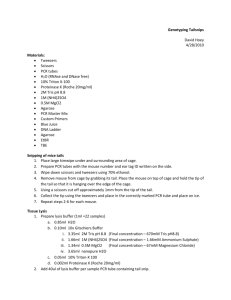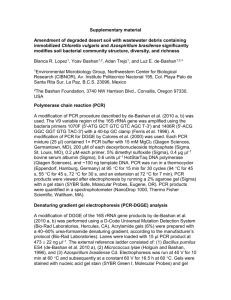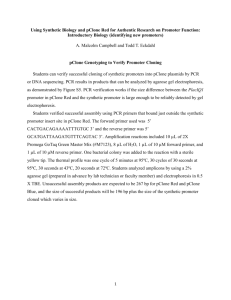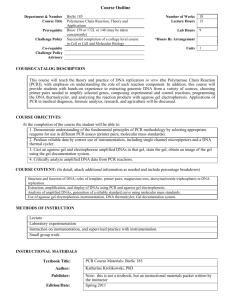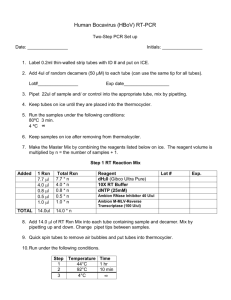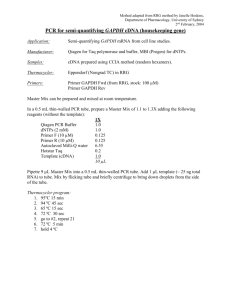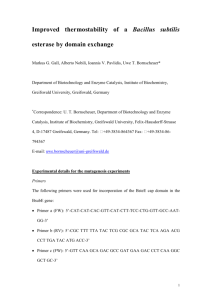PCR Instructions, doc
advertisement
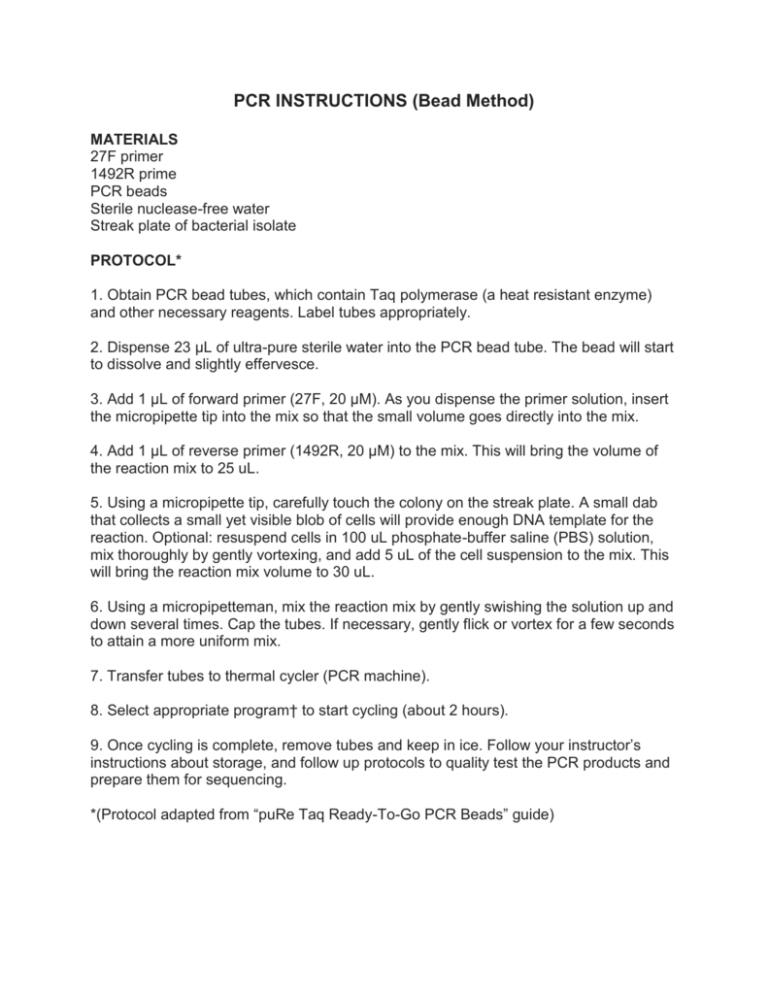
PCR INSTRUCTIONS (Bead Method) MATERIALS 27F primer 1492R prime PCR beads Sterile nuclease-free water Streak plate of bacterial isolate PROTOCOL* 1. Obtain PCR bead tubes, which contain Taq polymerase (a heat resistant enzyme) and other necessary reagents. Label tubes appropriately. 2. Dispense 23 μL of ultra-pure sterile water into the PCR bead tube. The bead will start to dissolve and slightly effervesce. 3. Add 1 μL of forward primer (27F, 20 μM). As you dispense the primer solution, insert the micropipette tip into the mix so that the small volume goes directly into the mix. 4. Add 1 μL of reverse primer (1492R, 20 μM) to the mix. This will bring the volume of the reaction mix to 25 uL. 5. Using a micropipette tip, carefully touch the colony on the streak plate. A small dab that collects a small yet visible blob of cells will provide enough DNA template for the reaction. Optional: resuspend cells in 100 uL phosphate-buffer saline (PBS) solution, mix thoroughly by gently vortexing, and add 5 uL of the cell suspension to the mix. This will bring the reaction mix volume to 30 uL. 6. Using a micropipetteman, mix the reaction mix by gently swishing the solution up and down several times. Cap the tubes. If necessary, gently flick or vortex for a few seconds to attain a more uniform mix. 7. Transfer tubes to thermal cycler (PCR machine). 8. Select appropriate program† to start cycling (about 2 hours). 9. Once cycling is complete, remove tubes and keep in ice. Follow your instructor’s instructions about storage, and follow up protocols to quality test the PCR products and prepare them for sequencing. *(Protocol adapted from “puRe Taq Ready-To-Go PCR Beads” guide) GEL ELECTROPHORESIS INSTRUCTIONS MATERIALS Agarose TBE buffer Ethidium bromide Erlenmeyer flask Microwave oven Loading dye Gel tray, comb, and gel electrophoresis apparatus UV chamber PROTOCOL 1. Weigh 1 g of agarose and mix with 100 mL TBE buffer in an Erlenmeyer flask – this will make a 1% agarose gel 2. Microwave contents of Erlenmeyer flask until boiling (1-2 mins) or until mixture becomes transparent. 3. Allow mixture to cool down (10-15 mins) 4. Carefully add 10 μL of ethidum bromide to mixture (Warning: ethidium bromide is a DNA intercalating agent and mutagen. Handle this compound only in designated areas. Wear gloves and avoid contact with skin). 5. Pour mixture into gel tray with appropriate comb and allow mixture to solidify (about 15 mins). 6. Carefully pull comb off gel. Place gel tray into chamber with TBE buffer and start loading wells: a. Load 1 kb ladder into first well. b. Mix 5 μL of PCR product with 1 μL loading dye and dispense into wells. 7. Plug electrodes on appropriate terminals of the chamber (keep in mind that DNA has a partial negative charge). 8. Allow gel to run for 40-60 minutes (at 100 milliamps/volt). 9. Finally, carefully remove gel from tray and place in UV chamber to get a photograph (expect to see continuous band at about 1.7 kb). 16S rRNA Primers: 27F 5’ – AGA GTT TGA TCM TGG CTC AG – 3’ 1492R 5’ – GTT ACC TTG TTA CGA CTT – 3’ M = A or C according to standard IUPAC ambiguity codes. PCR cycling: 94oC for 10 min if doing colony PCR (or else just 1min) 94oC 30 sec 58oC 30 sec 72oC 1 min 50 sec Cycle 30 times 72oC for 10min



